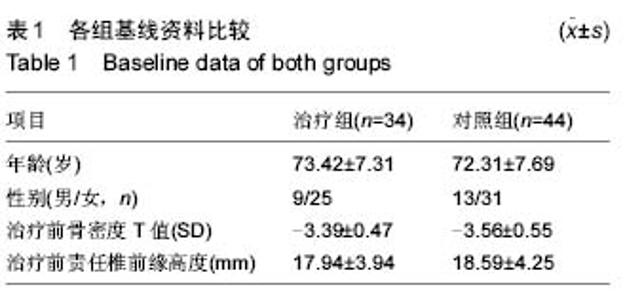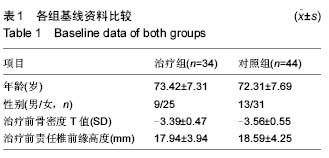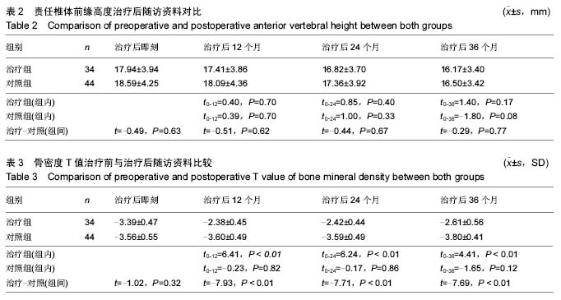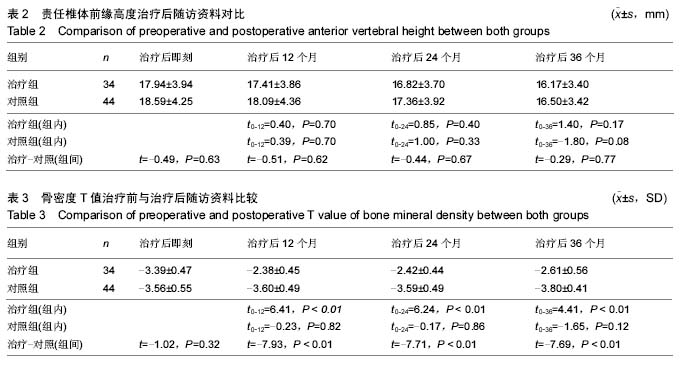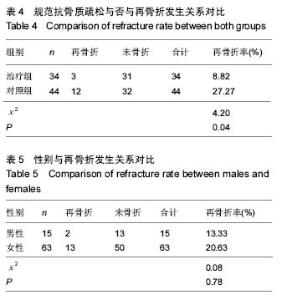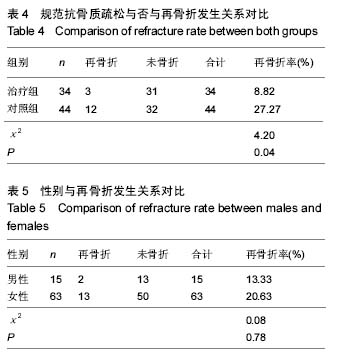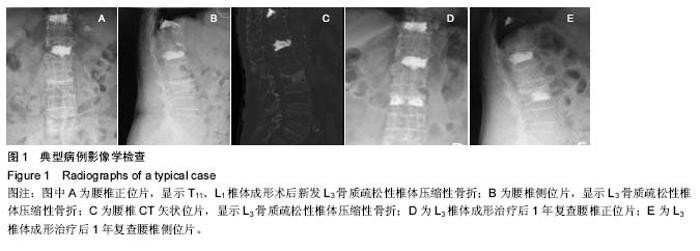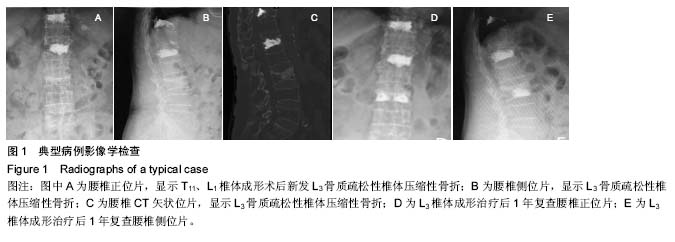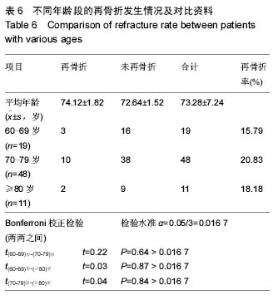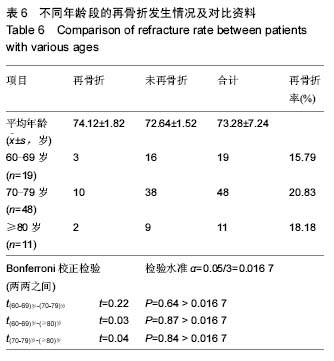Chinese Journal of Tissue Engineering Research ›› 2016, Vol. 20 ›› Issue (33): 4905-4912.doi: 10.3969/j.issn.2095-4344.2016.33.006
Previous Articles Next Articles
Vertebroplasty combined with anti-osteoporosis treatment reduces refracture rate
Yang Fu-guo, Yang Bo, Yin Biao, Li Shuang-qing, Yang Yi-xi, Gong Yi-xing
- Department of Orthopedics, the Third Affiliated Hospital of Guangzhou Medical University, Guangzhou 510150, Guangdong Province, China
-
Received:2016-05-24Online:2016-08-12Published:2016-08-12 -
Contact:Yang Bo, M.D., Chief physician, Professor, Department of Orthopedics, the Third Affiliated Hospital of Guangzhou Medical University, Guangzhou 510150, Guangdong Province, China -
About author:Yang Fu-guo, Studying for master’s degree, Department of Orthopedics, the Third Affiliated Hospital of Guangzhou Medical University, Guangzhou 510150, Guangdong Province, China -
Supported by:the Science and Technology Program of Guangdong Province, China, No. 2014A020212355; the Graduate Education Innovation Grant Program in Guangdong Province, China, No. B158035
CLC Number:
Cite this article
Yang Fu-guo, Yang Bo, Yin Biao, Li Shuang-qing, Yang Yi-xi, Gong Yi-xing. Vertebroplasty combined with anti-osteoporosis treatment reduces refracture rate[J]. Chinese Journal of Tissue Engineering Research, 2016, 20(33): 4905-4912.
share this article
| [1] 中华医学会骨质疏松和骨矿盐疾病分会.原发性骨质疏松症诊治指南(2011年)[J].中华骨质疏松和骨矿盐疾病杂志,2011,4(1):2-17. [2] 中华医学会骨质疏松和骨矿盐疾病分会,中华医学会骨科学分会骨质疏松学组.骨质疏松性骨折患者抗骨质疏松治疗与管理专家共识[J]. 中华骨质疏松和骨矿盐疾病杂志,2015,8(3):189-195. [3] Ford MA, Bass M, Zhao Y, et al. Osteoporosis Knowledge, Self-Efficacy, and Beliefs among College Students in the USA and China. J Osteoporos. 2011; 2011:729219. [4] Balasubramanian A, Tosi LL, Lane JM, et al. Declining rates of osteoporosis management following fragility fractures in the U.S., 2000 through 2009. J Bone Joint Surg Am. 2014;96(7):e52. [5] 廖二元,徐苓,朱汉民,等.原发性骨质疏松症干预的疗效监测与评估专家意见[J]. 中华骨质疏松和骨矿盐疾病杂志, 2015,8(1):1-6. [6] Cosman F, de Beur SJ, LeBoff MS, et al. Clinician's Guide to Prevention and Treatment of Osteoporosis. Osteoporos Int. 2014;25(10):2359-2381. [7] 李楠,张贵林,何达,等.骨水泥的分布与剂量对椎体成形术疗效影响的研究[J].中国骨与关节损伤杂志,2015,30(1): 66-68. [8] Wang E, Yi H, Wang M, et al. Treatment of osteoporotic vertebral compression fractures with percutaneous kyphoplasty: a report of 196 cases. Eur J Orthop Surg Traumatol. 2013;23 Suppl 1:S71-75. [9] 章波,杨波,尹飚,等.经皮穿刺椎体成形术治疗90岁以上老人骨质疏松性椎体压缩性骨折[J].中国微创外科杂志, 2014,14(5):445-449. [10] 杨波,谢景开,尹飚,等.经皮椎体成形术治疗老年多节段骨质疏松性椎体压缩性骨折[J].中国矫形外科杂志,2012, 20(24): 2212-2216. [11] 黎双庆,杨波,杨逸禧,等.经皮穿刺椎体成形术治疗骨质疏松性严重椎体压缩性骨折[J].中国微创外科杂志,2015, 15(9):818-821. [12] 麦合木提江•穆海麦提,祝少博,李景峰,等.两种方法治疗骨质疏松致椎体压缩性骨折:安全与有效性的Meta分析[J].中国组织工程研究,2014,18(22):3551-3559. [13] 蓝涛,陈扬,杨欣建. 椎体成形术后再骨折研究进展[J]. 中国脊柱脊髓杂志,2015,25(2):179-182. [14] Klazen CA, Venmans A, de Vries J, et al. Percutaneous vertebroplasty is not a risk factor for new osteoporotic compression fractures: results from VERTOS II. AJNR Am J Neuroradiol. 2010;31(8): 1447-1450. [15] Lu K, Liang CL, Hsieh CH, et al. Risk factors of subsequent vertebral compression fractures after vertebroplasty. Pain Med. 2012;13(3):376-382. [16] Yoo CM, Park KB, Hwang SH, et al. The analysis of patterns and risk factors of newly developed vertebral compression fractures after percutaneous vertebroplasty. J Korean Neurosurg Soc. 2012; 52(4): 339-345. [17] Lin WC, Lee YC, Lee CH, et al. Refractures in cemented vertebrae after percutaneous vertebroplasty: a retrospective analysis. Eur Spine J. 2008;17(4):592-599. [18] Kim YY, Rhyu KW. Recompression of vertebral body after balloon kyphoplasty for osteoporotic vertebral compression fracture. Eur Spine J. 2010;19(11): 1907-1912. [19] DePalma MJ, Ketchum JM, Frankel BM, et al. Percutaneous vertebroplasty for osteoporotic vertebral compression fractures in the nonagenarians: a prospective study evaluating pain reduction and new symptomatic fracture rate. Spine (Phila Pa 1976). 2011;36(4):277-282. [20] Li YA, Lin CL, Chang MC, et al. Subsequent vertebral fracture after vertebroplasty: incidence and analysis of risk factors. Spine (Phila Pa 1976). 2012;37(3): 179-183. [21] Bawa HS, Weick J, Dirschl DR.Anti-Osteoporotic Therapy After Fragility Fracture Lowers Rate of Subsequent Fracture: Analysis of a Large Population Sample. J Bone Joint Surg Am. 2015;97(19): 1555-1562. [22] 林婕,沈芸.482例骨质疏松性骨折住院患者再次骨折分析[J].中国老年保健医学, 2015,13(4):47-49. [23] 邱贵兴,裴福兴,胡侦明,等. 中国骨质疏松性骨折诊疗指南(骨质疏松性骨折诊断及治疗原则)[J].中华骨与关节外科杂志,2015,8(5):371-375. [24] 印平,马远征,马迅,等.骨质疏松性椎体压缩性骨折的治疗指南[J]. 中国骨质疏松杂志,2015,21(6):643-648. [25] Oudshoorn C, Hartholt KA, Zillikens MC, et al. Emergency department visits due to vertebral fractures in the Netherlands, 1986-2008: steep increase in the oldest old, strong association with falls. Injury. 2012; 43(4):458-461. [26] Rad AE, Gray LA, Sinaki M, et al. Role of physical activity in new onset fractures after percutaneous vertebroplasty. Acta Radiol. 2011;52(9):1020-1023. [27] Zafeiris CP, Lyritis GP, Papaioannou NA, et al. Hypovitaminosis D as a risk factor of subsequent vertebral fractures after kyphoplasty. Spine J. 2012; 12(4):304-312. [28] Harrop JS, Prpa B, Reinhardt MK, et al. Primary and secondary osteoporosis' incidence of subsequent vertebral compression fractures after kyphoplasty. Spine (Phila Pa 1976). 2004;29(19):2120-2125. [29] 中华医学会骨质疏松和骨矿盐疾病分会,中华医学会骨科学分会骨质疏松学组.骨质疏松性骨折患者抗骨质疏松治疗与管理专家共识[J]. 中华骨质疏松和骨矿盐疾病杂志,2015,8(3):189-195. [30] Su CH, Tu PH, Yang TC, et al. Comparison of the therapeutic effect of teriparatide with that of combined vertebroplasty with antiresorptive agents for the treatment of new-onset adjacent vertebral compression fracture after percutaneous vertebroplasty. J Spinal Disord Tech. 2013;26(4):200-206. [31] 杜艳萍,朱汉民,李慧林,等.绝经后妇女使用抗骨质疏松症药物的依从性及其影响因素分析[J].中国骨质疏松杂志, 2012,18(2): 302-306. [32] 常青,史相钦. PKP结合抗骨质疏松药物治疗骨质疏松性椎体压缩性骨折疗效观察[J].中国骨与关节损伤杂志, 2015,30(5):522-523. [33] 陈剑峰,王建伟,杨智杰. 椎体后凸成形术后椎体再发骨折9例分析[J]. 江苏医药,2014,40(24):3073-3074. [34] 杨刘柱,陈仲,严鑫平,等. 椎体骨水泥注入联合抗骨质疏松药物治疗急性骨质疏松性椎体压缩性骨折[J]. 中国组织工程研究,2014,18(39):6265-6270. [35] 何晓辉,王明森,汪道清,等.伊班磷酸钠在多发性老年骨质疏松性脊柱骨折术后的应用[J].海南医学,2016,27(2): 213-216. [36] 王英东,孙永新.鲑鱼降钙素联合维生素D在预防老年骨质疏松患者全髋关节置换术后跌倒中的应用[J].中国医药导刊,2015,17(5):471-472. [37] 彭鹏,王清.经皮椎体成形术后给予抗骨质疏松药物治疗对再发脊柱椎体压缩骨折的疗效观察[J].中国实用医药, 2015,10(26):145-146. [38] 唐佩福.抗骨质疏松治疗对骨质疏松性骨折的治疗影响及建议[J].中华老年多器官疾病杂志,2014,13(7): 481-484. [39] 余舒芳,林建华,李毅中,等.骨质疏松性骨折二级预防的综合管理--骨质疏松性骨折二级预防示范基地福州中心专家共识[J].中华关节外科杂志:电子版,2014,8(6): 808-812. [40] 袁宏,钟惠琴,陆琳松,等.全髋关节置换术后联合抗骨质疏松治疗的价值[J].中华关节外科杂志:电子版,2014,8(3): 376-379. [41] 袁宏,陆琳松,钟惠琴, 等.唑来膦酸对骨质疏松患者全髋关节置换术后假体周围骨密度的影响[J].中华关节外科杂志:电子版,2014,8(3):278-285. |
| [1] | Zhang Tongtong, Wang Zhonghua, Wen Jie, Song Yuxin, Liu Lin. Application of three-dimensional printing model in surgical resection and reconstruction of cervical tumor [J]. Chinese Journal of Tissue Engineering Research, 2021, 25(9): 1335-1339. |
| [2] | Zeng Yanhua, Hao Yanlei. In vitro culture and purification of Schwann cells: a systematic review [J]. Chinese Journal of Tissue Engineering Research, 2021, 25(7): 1135-1141. |
| [3] | Xu Dongzi, Zhang Ting, Ouyang Zhaolian. The global competitive situation of cardiac tissue engineering based on patent analysis [J]. Chinese Journal of Tissue Engineering Research, 2021, 25(5): 807-812. |
| [4] | Wu Zijian, Hu Zhaoduan, Xie Youqiong, Wang Feng, Li Jia, Li Bocun, Cai Guowei, Peng Rui. Three-dimensional printing technology and bone tissue engineering research: literature metrology and visual analysis of research hotspots [J]. Chinese Journal of Tissue Engineering Research, 2021, 25(4): 564-569. |
| [5] | Chang Wenliao, Zhao Jie, Sun Xiaoliang, Wang Kun, Wu Guofeng, Zhou Jian, Li Shuxiang, Sun Han. Material selection, theoretical design and biomimetic function of artificial periosteum [J]. Chinese Journal of Tissue Engineering Research, 2021, 25(4): 600-606. |
| [6] | Liu Fei, Cui Yutao, Liu He. Advantages and problems of local antibiotic delivery system in the treatment of osteomyelitis [J]. Chinese Journal of Tissue Engineering Research, 2021, 25(4): 614-620. |
| [7] | Li Xiaozhuang, Duan Hao, Wang Weizhou, Tang Zhihong, Wang Yanghao, He Fei. Application of bone tissue engineering materials in the treatment of bone defect diseases in vivo [J]. Chinese Journal of Tissue Engineering Research, 2021, 25(4): 626-631. |
| [8] | Zhang Zhenkun, Li Zhe, Li Ya, Wang Yingying, Wang Yaping, Zhou Xinkui, Ma Shanshan, Guan Fangxia. Application of alginate based hydrogels/dressings in wound healing: sustained, dynamic and sequential release [J]. Chinese Journal of Tissue Engineering Research, 2021, 25(4): 638-643. |
| [9] | Chen Jiana, Qiu Yanling, Nie Minhai, Liu Xuqian. Tissue engineering scaffolds in repairing oral and maxillofacial soft tissue defects [J]. Chinese Journal of Tissue Engineering Research, 2021, 25(4): 644-650. |
| [10] | Xing Hao, Zhang Yonghong, Wang Dong. Advantages and disadvantages of repairing large-segment bone defect [J]. Chinese Journal of Tissue Engineering Research, 2021, 25(3): 426-430. |
| [11] | Zhong Yuanming, Wan Tong, Zhong Xifeng, Wu Zhuotan, He Bingkun, Wu Sixian. Meta-analysis of the efficacy and safety of percutaneous curved vertebroplasty and unilateral pedicle approach percutaneous vertebroplasty in the treatment of osteoporotic vertebral compression fracture [J]. Chinese Journal of Tissue Engineering Research, 2021, 25(3): 456-462. |
| [12] | Feng Guancheng, Fang Jianming, Lü Haoran, Zhang Dongsheng, Wei Jiadong, Yu Bingbing. How does bone cement dispersion affect the early outcome of percutaneous vertebroplasty [J]. Chinese Journal of Tissue Engineering Research, 2021, 25(22): 3450-3457. |
| [13] | Chen Siqi, Xian Debin, Xu Rongsheng, Qin Zhongjie, Zhang Lei, Xia Delin. Effects of bone marrow mesenchymal stem cells and human umbilical vein endothelial cells combined with hydroxyapatite-tricalcium phosphate scaffolds on early angiogenesis in skull defect repair in rats [J]. Chinese Journal of Tissue Engineering Research, 2021, 25(22): 3458-3465. |
| [14] | Wang Hao, Chen Mingxue, Li Junkang, Luo Xujiang, Peng Liqing, Li Huo, Huang Bo, Tian Guangzhao, Liu Shuyun, Sui Xiang, Huang Jingxiang, Guo Quanyi, Lu Xiaobo. Decellularized porcine skin matrix for tissue-engineered meniscus scaffold [J]. Chinese Journal of Tissue Engineering Research, 2021, 25(22): 3473-3478. |
| [15] | Mo Jianling, He Shaoru, Feng Bowen, Jian Minqiao, Zhang Xiaohui, Liu Caisheng, Liang Yijing, Liu Yumei, Chen Liang, Zhou Haiyu, Liu Yanhui. Forming prevascularized cell sheets and the expression of angiogenesis-related factors [J]. Chinese Journal of Tissue Engineering Research, 2021, 25(22): 3479-3486. |
| Viewed | ||||||
|
Full text |
|
|||||
|
Abstract |
|
|||||
